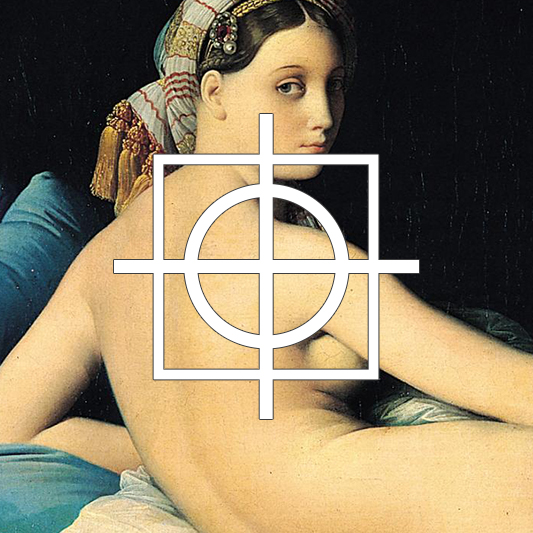本文最初發表於我和妻子的微信公眾號: 人面魚Fisage, 有增改。
一. 什麼是錐子臉: 倒水滴、尖下巴和蛇精臉
“錐子臉”, 常見于網紅,屬於誇張版極致版的“瓜子臉”: 指的是女性臉龐的咬肌和頜骨不突出,下巴鋒利呈現錐子狀,整體臉型像是倒置的一滴水滴。無數女明星和網紅為了好看,去美容院將大腮幫子磨小,小腮幫子磨平,P圖的時候往死裏P, 於是明星網紅們一個接一個撞臉,千人一面的白瘦錐子臉、大眼睛、高鼻子,這真是太恐怖又荒唐的事情。這些女人一定是瘋了,如果不是我們的審美出現問題,那麼這個時代的審美一定是病了。肉肉的,充滿活力的圓臉是多好看啊!
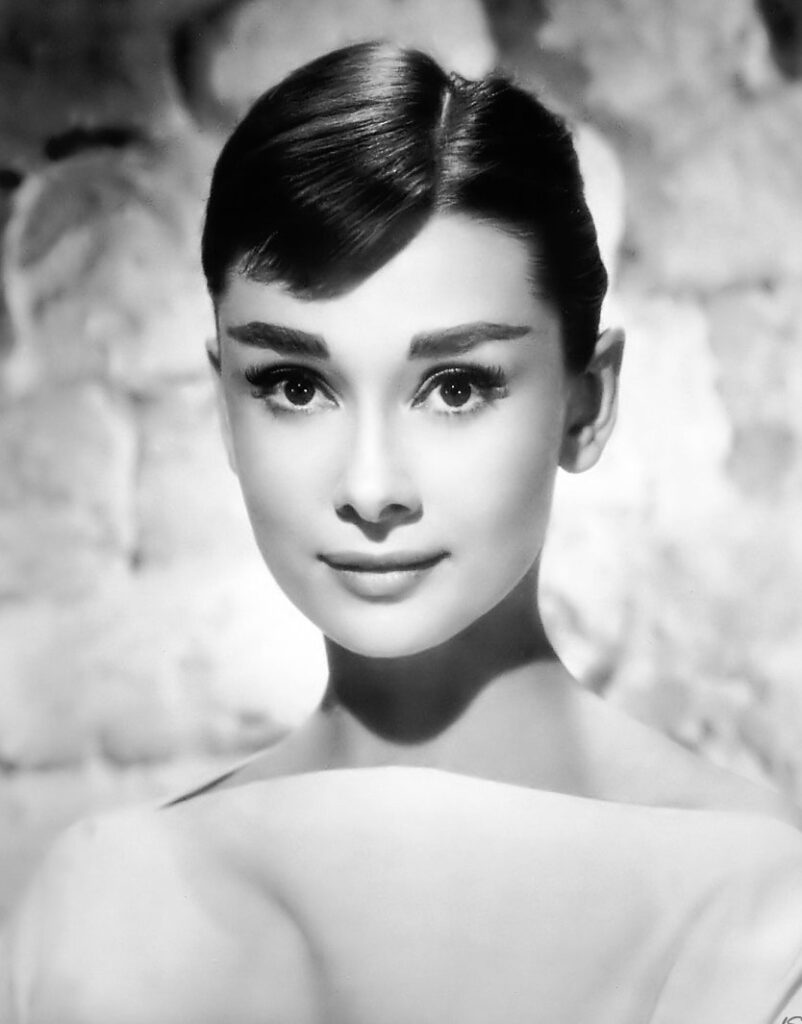
奧黛麗·赫本

全智賢
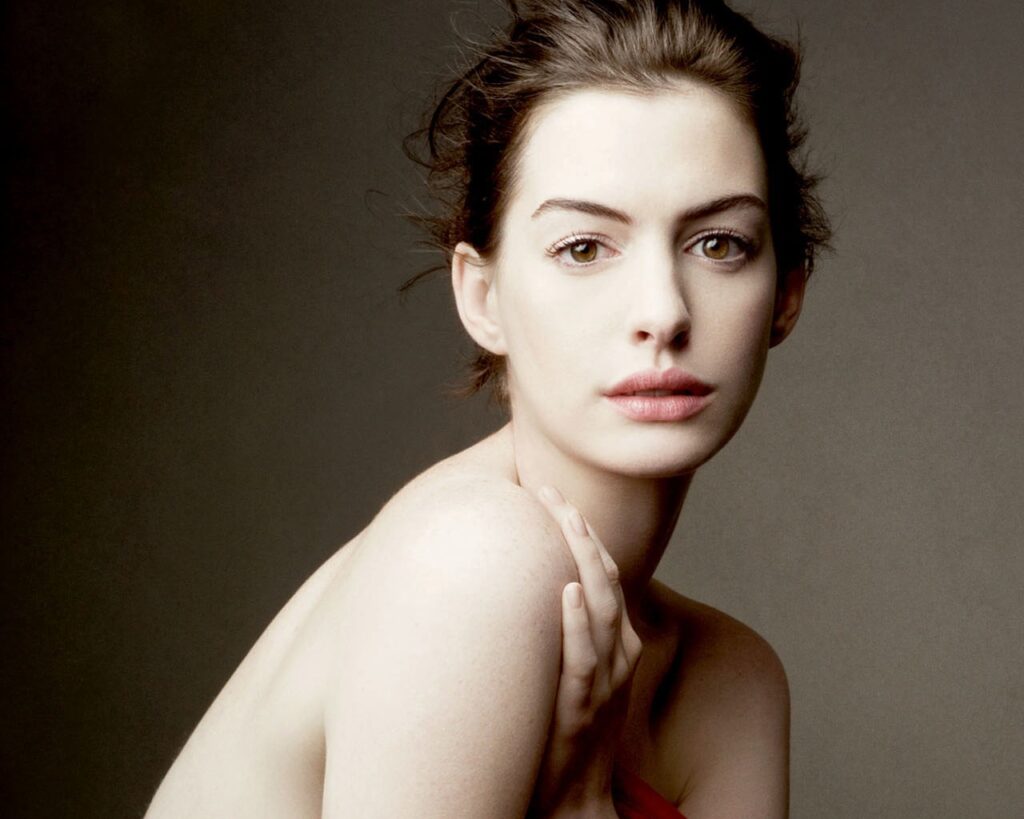
安妮·海瑟薇
二. 西方古典女性審美傾向于讚美恣意生長的生命力
從歷史縱向坐標軸的古希臘、文藝復興時代來看,西方古代數學家與幾何學家,劃分出各種最適合人類的審美比例: 橢圓才是最適合人類的臉部形狀。
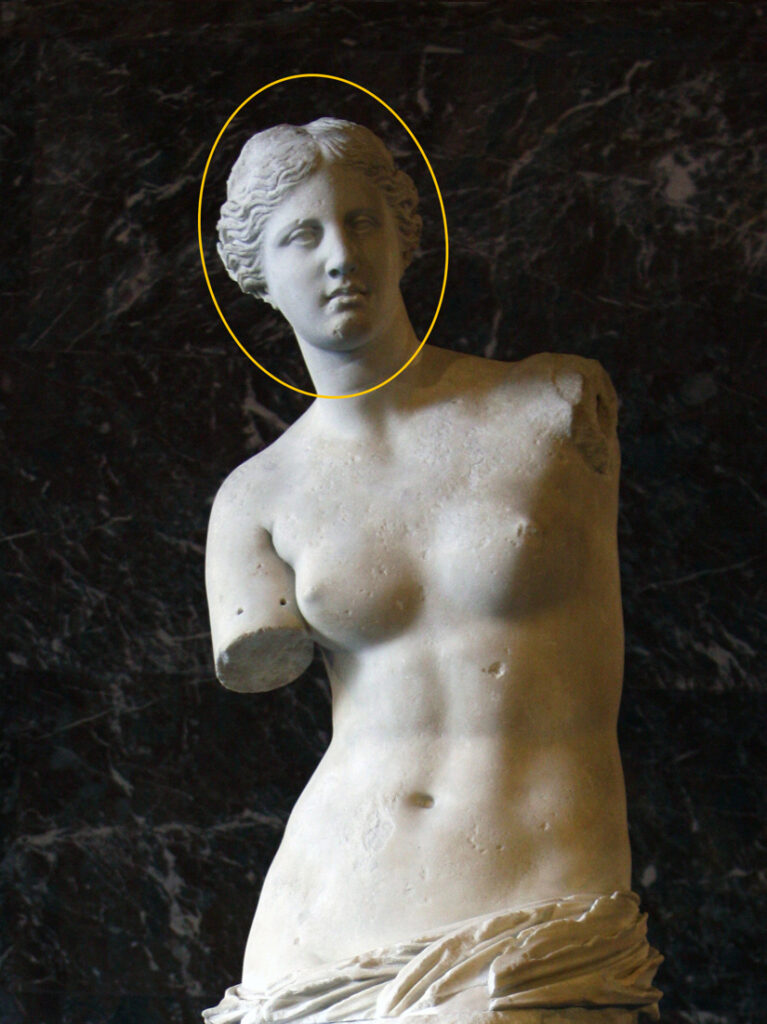
米羅的維納斯
古希臘哲學家們認為可以用數學關係來解釋世界和宇宙,畢達哥拉斯(Pythagoras, Πυθαγόρας ὁ Σάμιος, [1])一直認為,球體(圓形)是最完美的形體,所以宇宙本身可以是一個球體,而人體作為宇宙真理的縮影,最完美的比例是九頭身,頭部最完美的形狀是橢圓球體。圓形給人安穩、完滿的感覺,線條自然流暢,象徵美好、自給自足、生生不息的生命力–所以才有了著名的斷臂美神(Vénus de Milo, Αφροδίτη της Μήλου, [2]), 有了擲鐵餅者(the Discobolus of Myron, Δισκοβόλος, [3])。直到文藝復興,不論是波提切利(Sandro Botticelli, [4])的《維納斯的誕生(La Nascita di Venere, [5])》裏女神的臉型,再到達芬奇(Leonardo da Vinci, [6])筆下的《蒙娜麗莎(La Gioconda, Mona Lisa, [7])》還是《岩間聖母(Vergine dell Rocce, [8])》, 人物頭部也都是美麗優雅、隱藏在柔和而豐富層次陰影裏的美妙圓形–我們一定不會忘記他被老師逼迫不停畫蛋的故事–還是拉斐爾(Raffaello Sanzio da Urbino, [9])略顯甜膩的聖家庭肖像,沒有一個人物的臉型,不是優雅而俱有柔和曲線的鵝蛋形。即便是到了近代的法國宮廷(cour de France),女王和貴婦們,也無一不是以俱有富雕塑感而圓潤、瓷實的頭顱和肉感、豐腴、彈性十足並蘊含勃發生命的肉體而傲然不已。
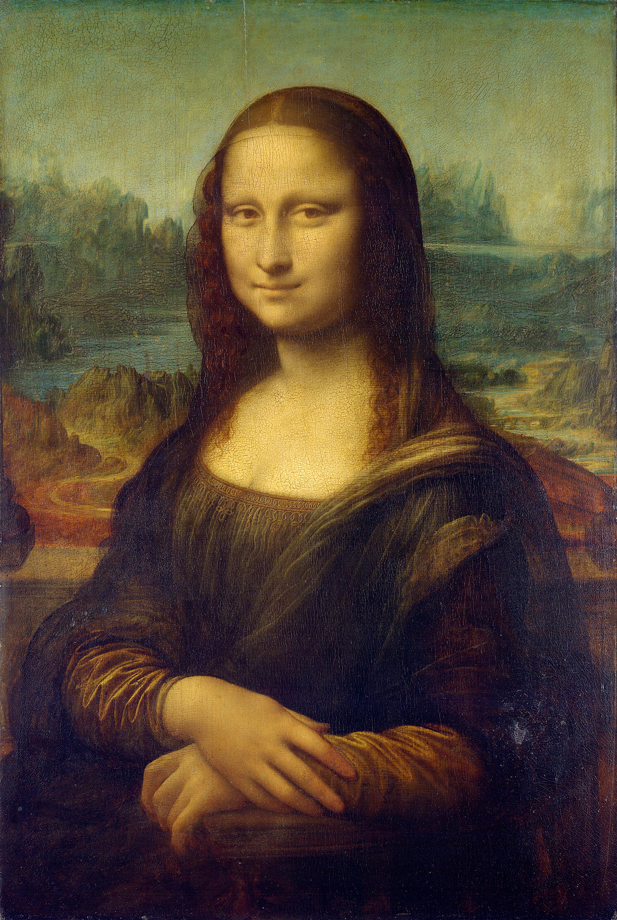
達芬奇: 蒙娜麗莎
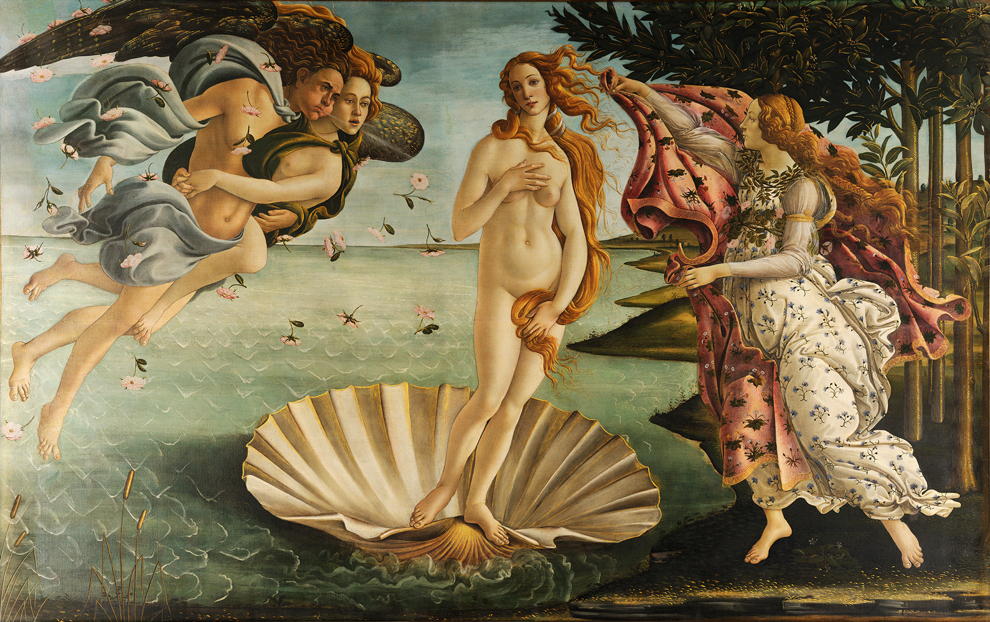
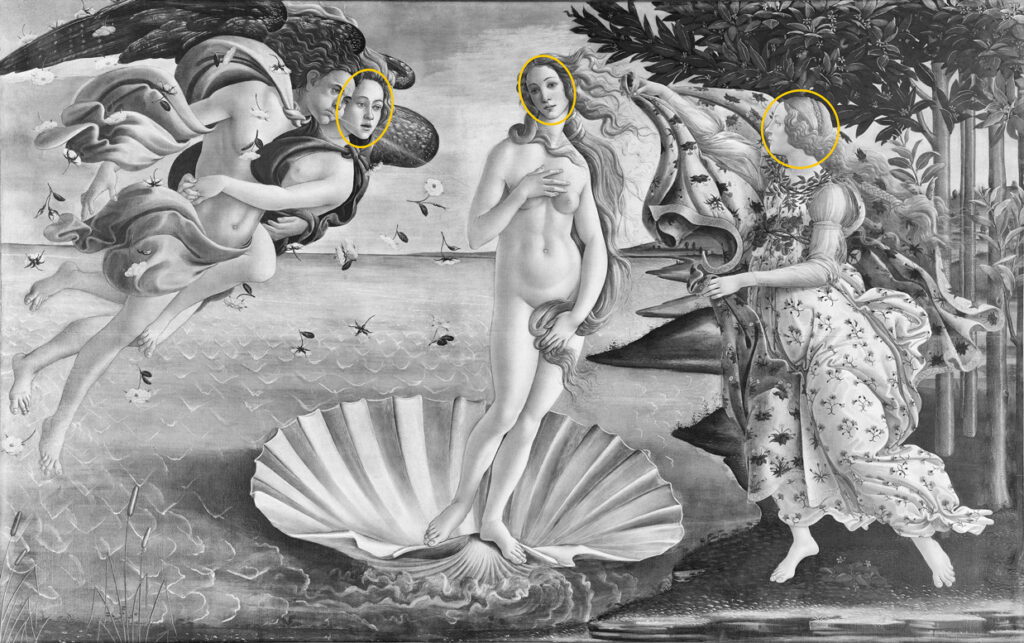
波提切利: 維納斯之誕生
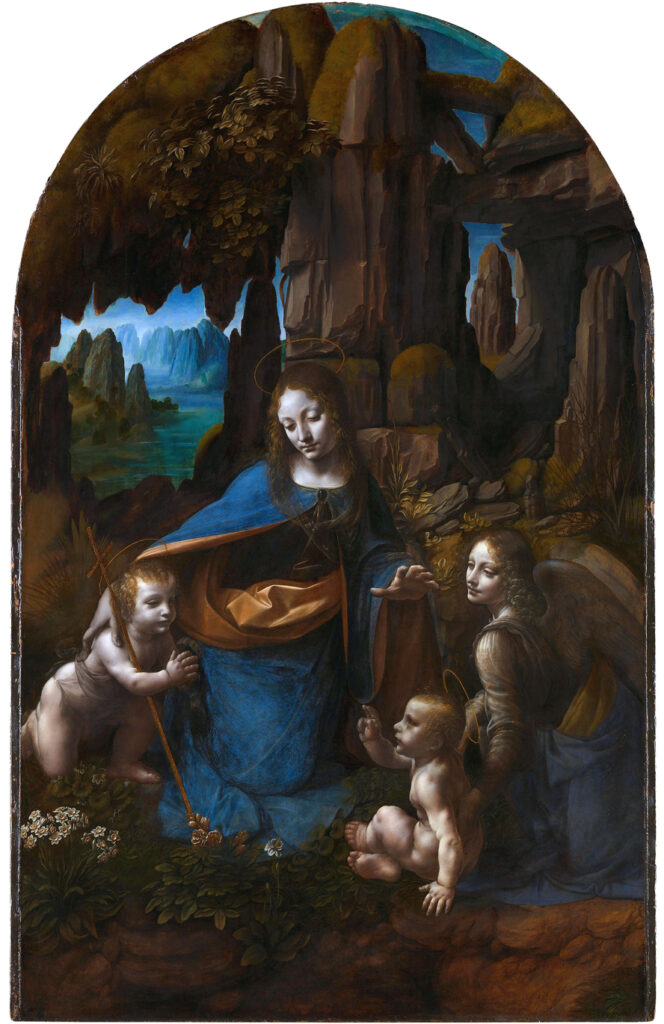
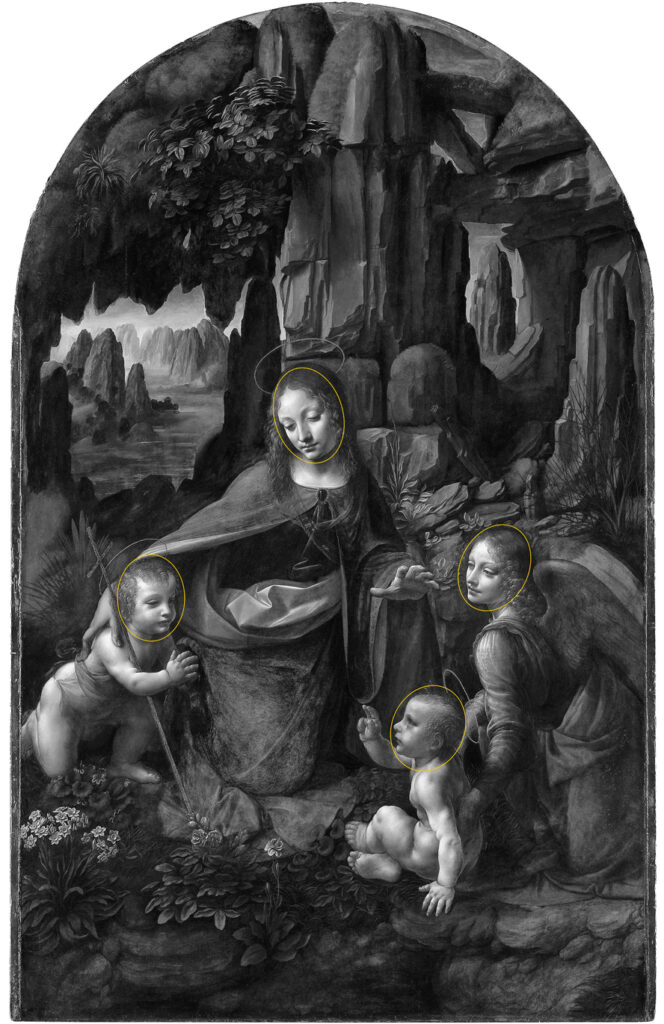
達芬奇: 岩間聖母
可以說,從古希臘至西方近代的經典審美史,就是一部讚頌女性美好、絢爛、青春勃發而富含濃鬱生命力和繁衍力的歷史。無怪乎無數西方經典藝術品裏的女性胴體,沒有一個不是豐滿、水嫩、飽含力量與韌性,發出耀目的微光,猶如清晨的第一束光線在其上跳躍舞蹈。
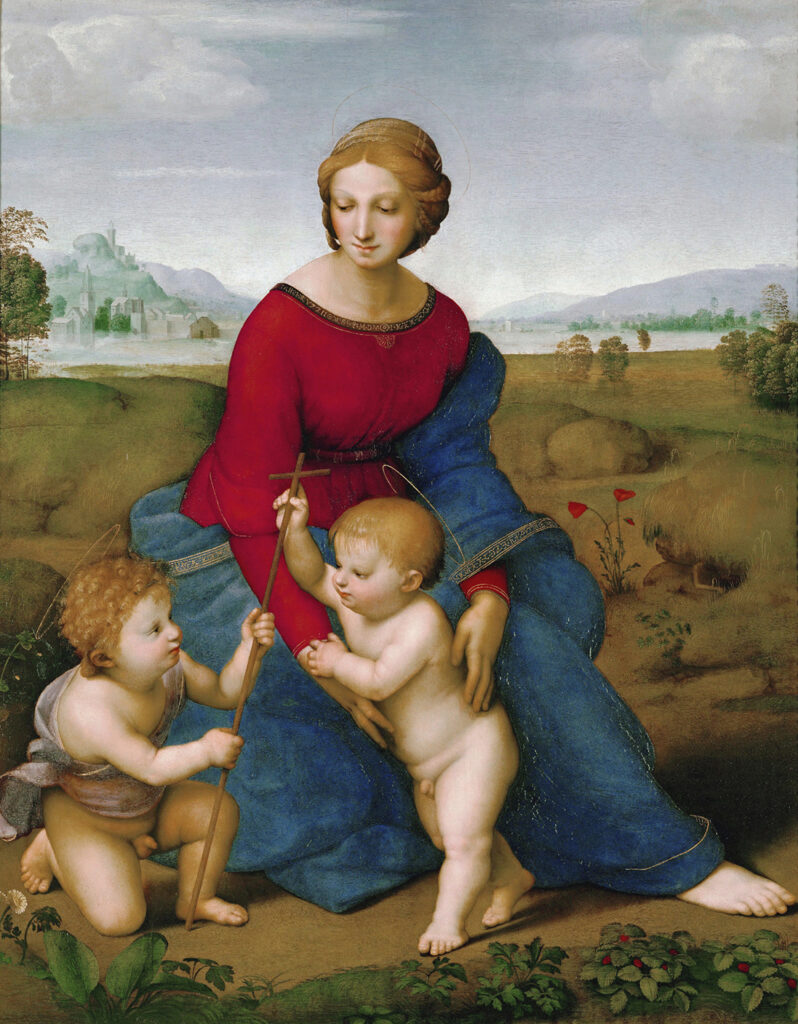
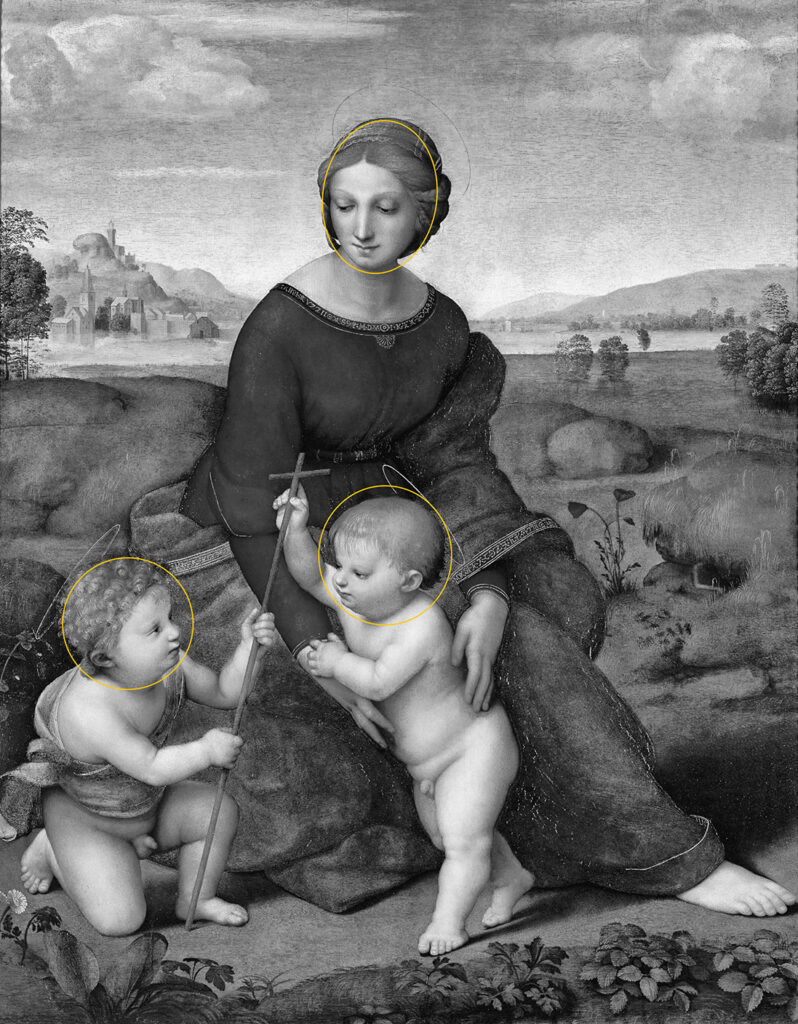
拉斐爾: 草地上的聖母
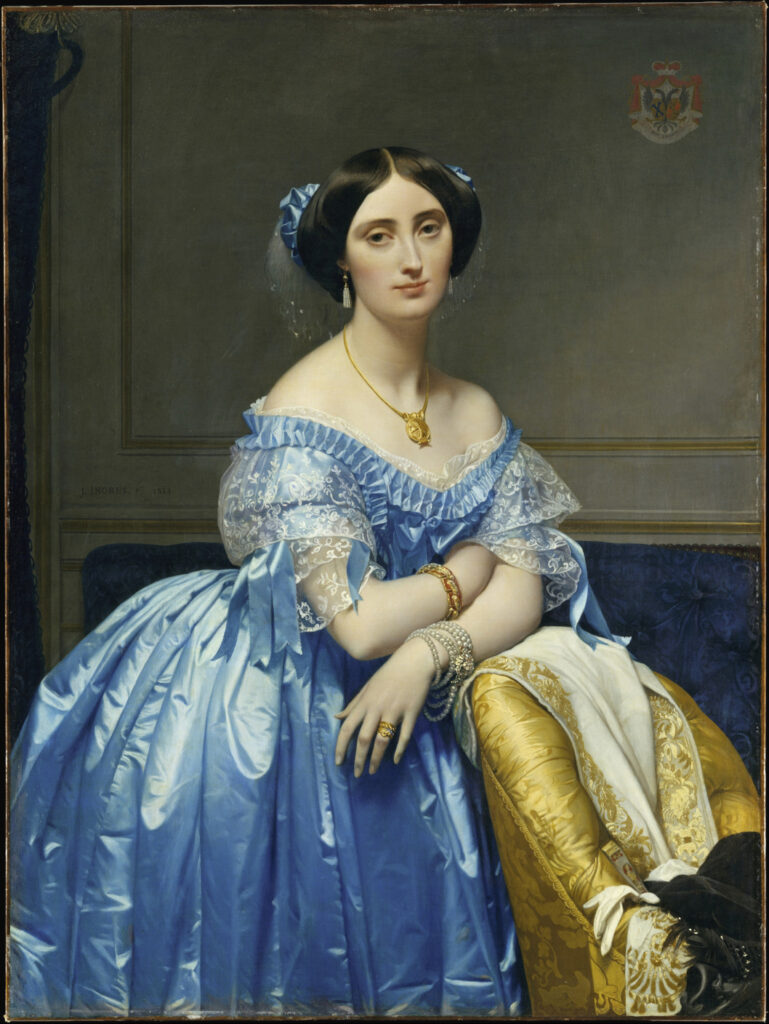
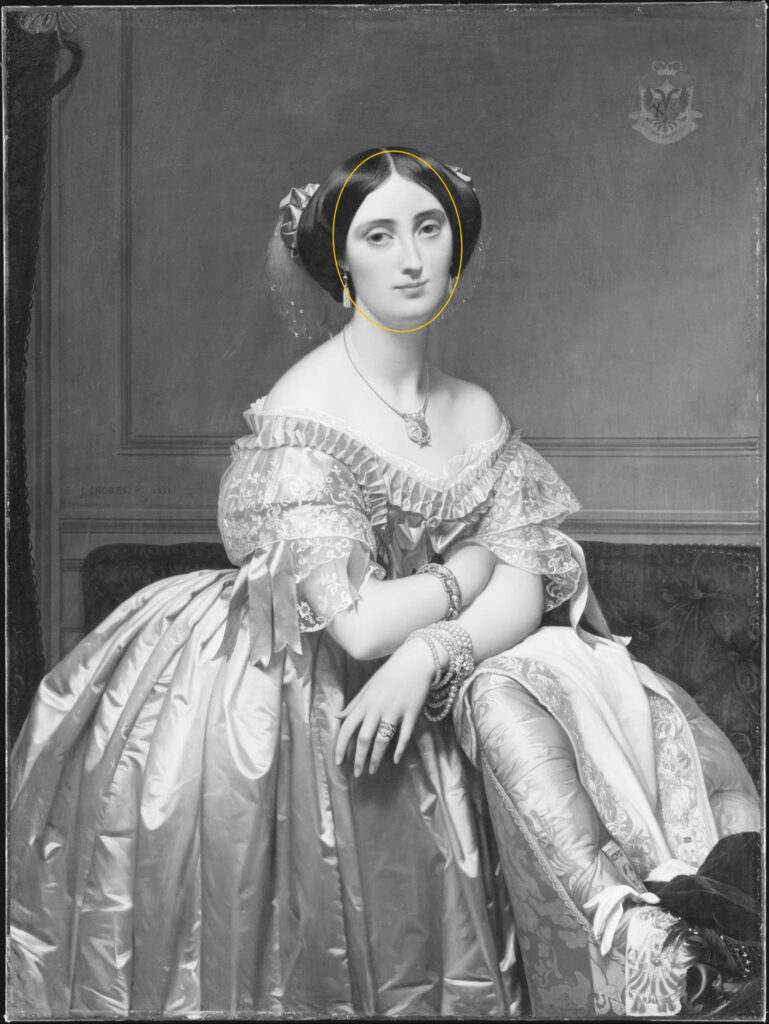
安格爾: 阿爾伯特·德·布洛格莉公主
三. 中國古典女性審美: 柔弱–能激起男子保護欲,妖媚–滿足男人異化的情慾
我小的時候,一直為自己不夠纖弱嬌小而耿耿於懷,心目中最美的姑娘應該就是瓜子臉、柳葉眉、櫻桃小嘴。不管是《紅樓夢》裏的林黛玉,還是《西廂記》裏的崔鶯鶯,都是“靜若嬌花照水,動則弱柳扶風。”這樣的姑娘才能激發中國男性骨子裏的保護欲和佔有慾。
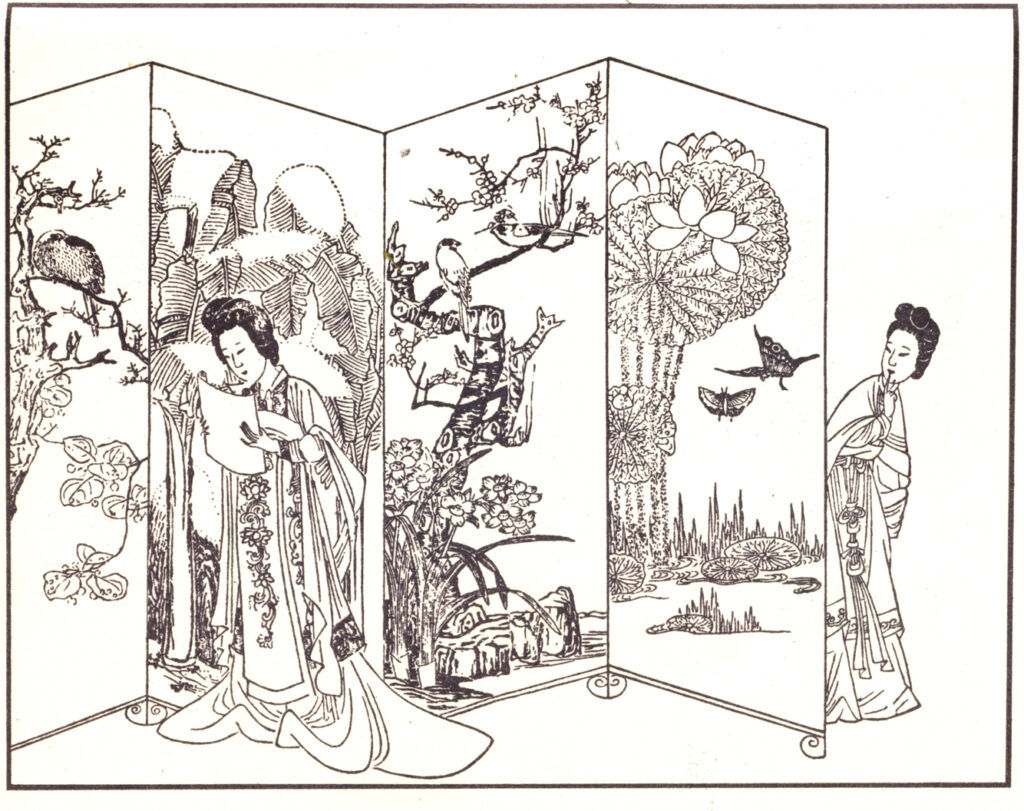
陳洪綬: 《西廂記》插圖
和西方油畫中女性恣意生長、飽滿有肉的女性曲線不同,中國傳統女性瘦弱的形體,和“瓜子臉(錐子臉)”、削肩、小蠻腰、 三寸金蓮一樣,某種程度上體現了中國男性和西方男性截然不同的“大男子主義”審美觀。中國男人被儒家文化和程朱理學“存天理,滅人欲”的觀念影響,被“君君臣臣父父子子”的條條框框束縛,被儒家繁重複雜的倫理道德控制,生命能量長久被壓抑,虛假的自尊又迫使他們通過”弱化女性”、沈溺於不平等的兩性關係和多妻制來滿足他們對於女性的優越感和支配欲。
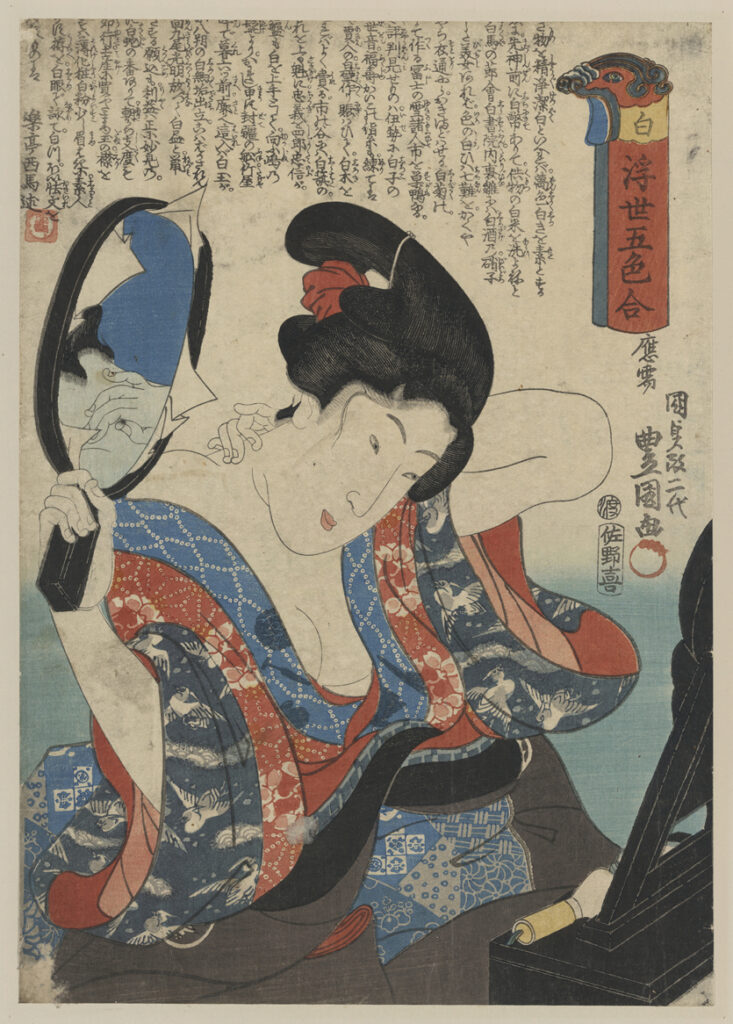
浮世繪,一
不過,中國男人對於女人家庭角色的期待和需求又衍生了另一種類型的審美: 鵝蛋臉女性。不同於瓜子臉女性的柔弱、敏感、神經質和小女人,同樣是《紅樓夢》裏的奇女子, 鵝蛋臉的薛寶釵顯然是一個更適合傳統大家族男性希望的妻子類型: 識大體、善於和人相處、擅長處理複雜的人際關係,堅強,且更俱力量感。這個有著圓形臉龐的女人符合中國男人的另一種幻想–她孝事公婆,善於團結,不會像《金瓶梅》裏的幾大女主爭風吃醋,使男人後院著火; 她善良隱忍,有委屈也可以為了大局而做出自我犧牲。男性在遭遇挫折時需要有力量感的女性喚醒其孱弱不堪的生命力,在日常生活中又傾向于嬌柔小女子式的崇拜襯托其價值快感。某種意義上,“瓜子臉”的女性就是為了映襯“鵝蛋臉”女性,她們各自是雙方的反面鏡像,是中國男性對於女性力量的另一種“互補式”想像。
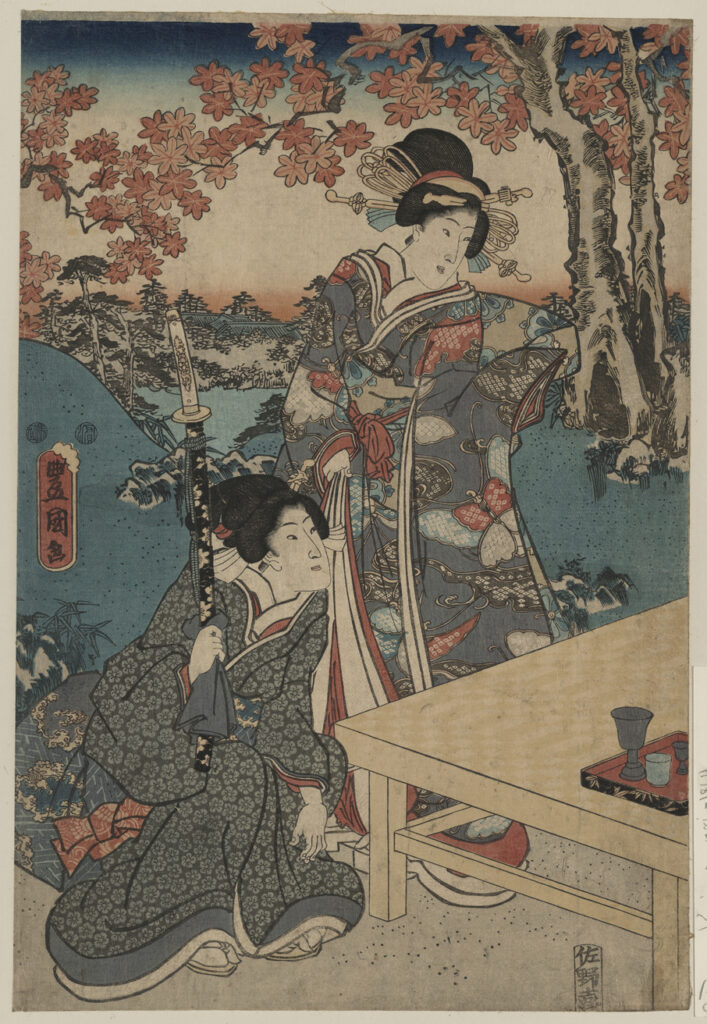
浮世繪,二
就像男人心中永遠都有一個完美的“鵝蛋臉”妻子,他們心中同樣也有一個千呼萬喚的“瓜子臉”情人。結了婚的男人看到妻子,湧起來的都是無盡的責任和沈沈的壓力,而想到情人,激起的則是欲望、發洩和銷魂。當代中國人被金錢物慾所完全控制、所任意擺佈,同樣饑渴的女人們也甘願變成男人欲望的節點(node),通過整形成男人熱衷的“錐子臉”、大眼睛、雙眼皮、高鼻梁、尖下巴,以期獲得搭上這直達慾海的“欲望號”街車車票。
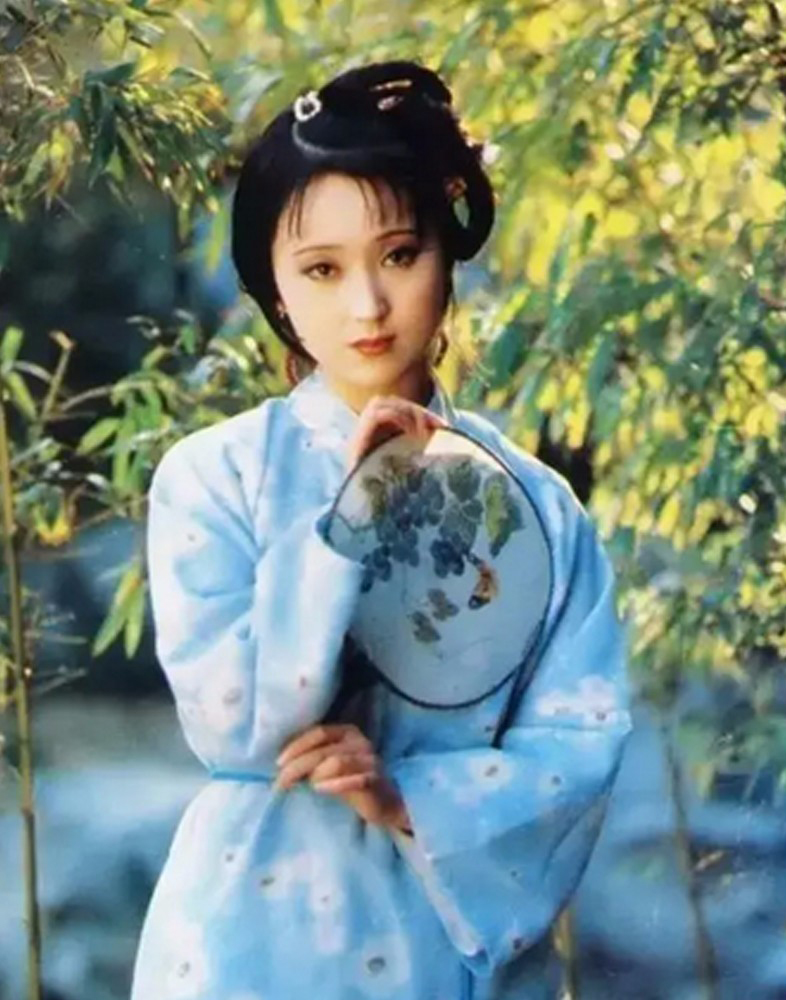
林黛玉
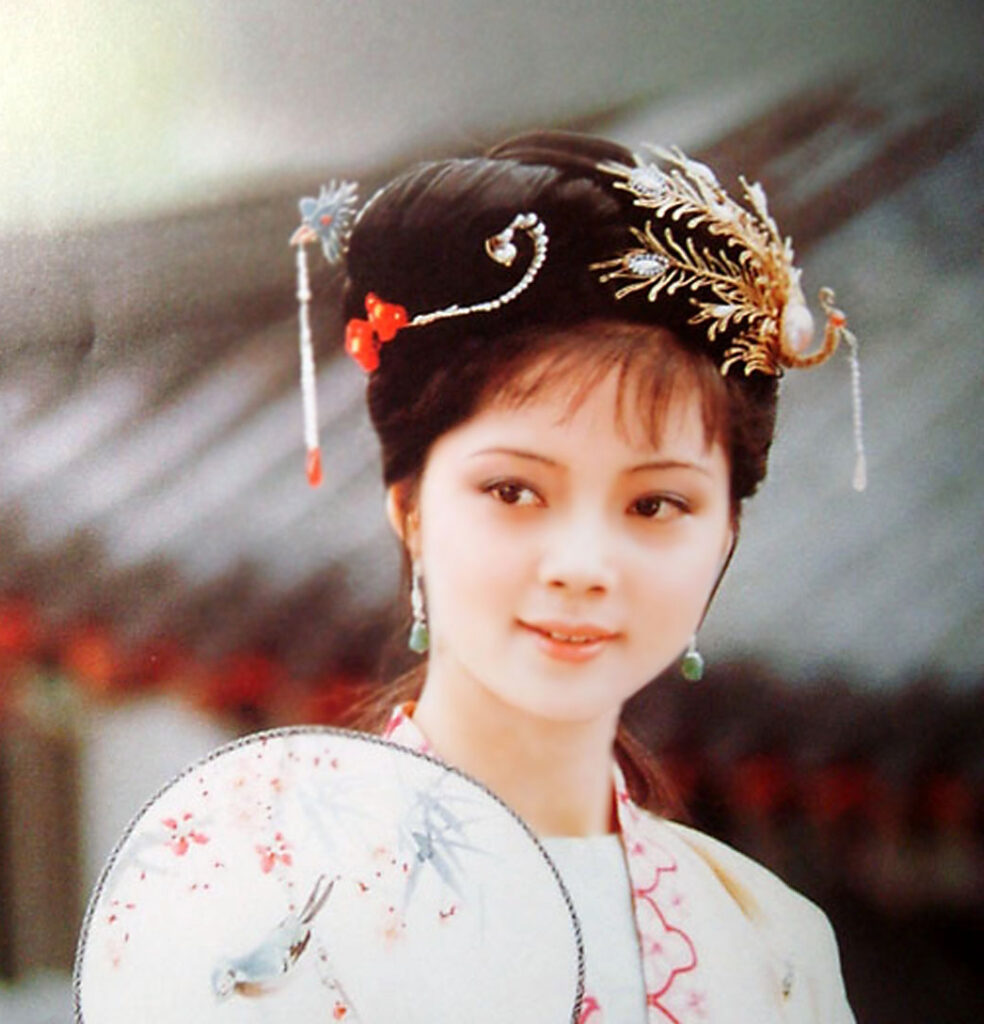
薛寶釵
此外,根據中國古代的面相學理論,比起福薄緣淺的“瓜子臉”, 飽滿有福的 “鵝蛋臉”也有諸多優勢: 圓潤沒有頭角的額頭不易與他人起衝突; 小顴骨不會過於強勢,代表柔順; 下頜不破壞整體的臉型曲線,隨和易相處; 如果還有一個稍微向前翹突的下巴,則可以盛得住福氣,晚景無憂。身體髮膚,受之父母,若女性否認自身的特點,去迎合時代千篇一律的審美,也是不自信和缺乏判斷與堅持的結果。
四. 碎片、快感、無深度–這個網絡時代荒唐的快餐式審美
這是一個最好的時代,也是一個最壞的時代。 This is the best of the time, this is the worst of the time. 查理斯·狄更斯 Charles John Huffam Dickens
“這是一個最好的時代,也是一個最壞的時代。” 女性看似從幾千年的三綱五常、道德倫理裏面解放出來,又陷入了新的“女性消費”之時代陷阱裏。
在這個荒唐的年代,欲望當道。在雜誌和螢屏上,在無數個直播App上,女性的美麗吸引來欲望的注視,隨時可以“變現”,換來巨大的收益。“錐子臉”在鏡頭前,看起來比圓臉和鵝蛋臉“上相”,更能夠喚起男性對女性性特徵的遐想。錐子臉女性比圓臉女性看起來更妖冶、時尚和狐媚,更俱有性吸引力–從視覺角度看,橢圓則因為受力均衡,更容易使人心平氣和,產生安全感,像倒水滴的“瓜子臉”下方是個突兀的尖角,容易產生不穩定和不安份的感覺,象徵了躁意、騷動和挑逗。比如,我們看《聊齋誌異》這樣的志怪小說,對於大戶人家千金閨秀的描述,和描繪鬼狐妖怪迥然有異–代表魅惑的狐妖或蛇精,永遠都是尖下巴,帶著勾人媚惑的大眼睛。
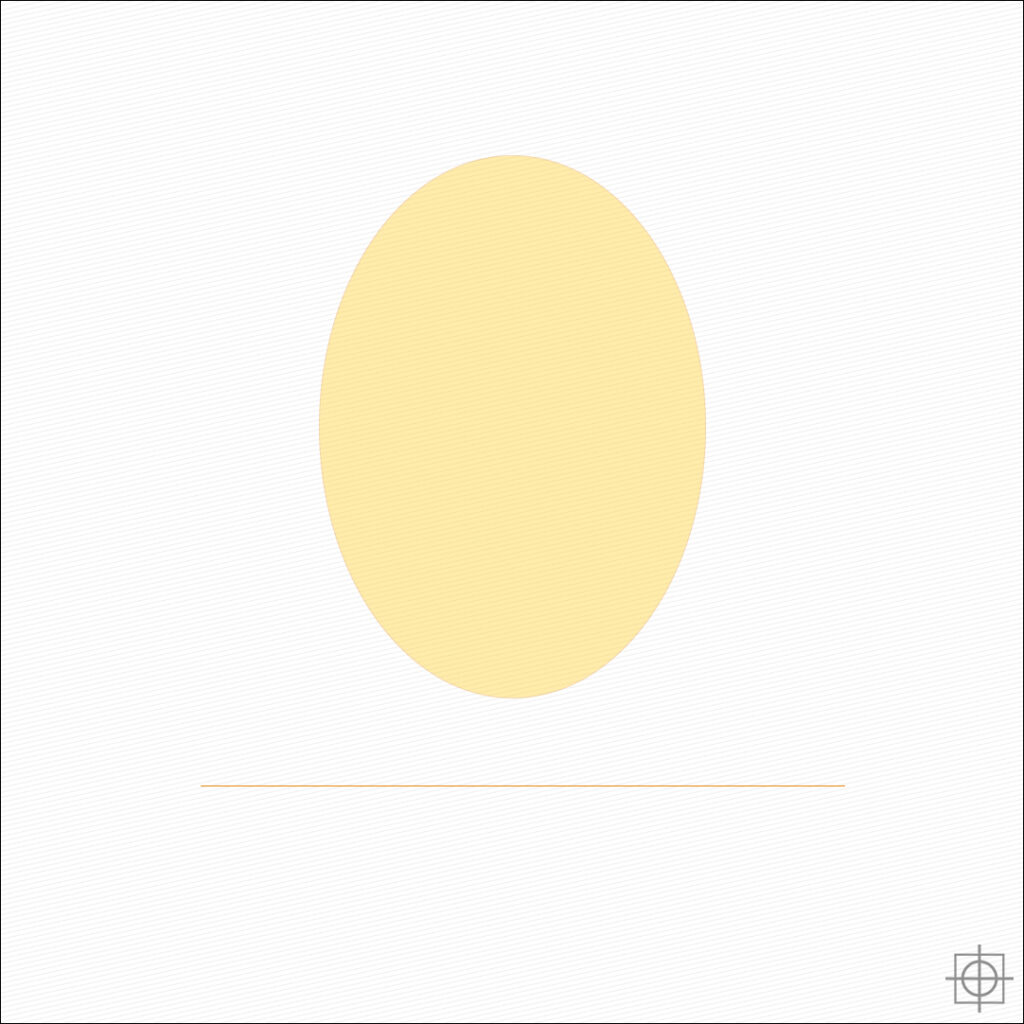
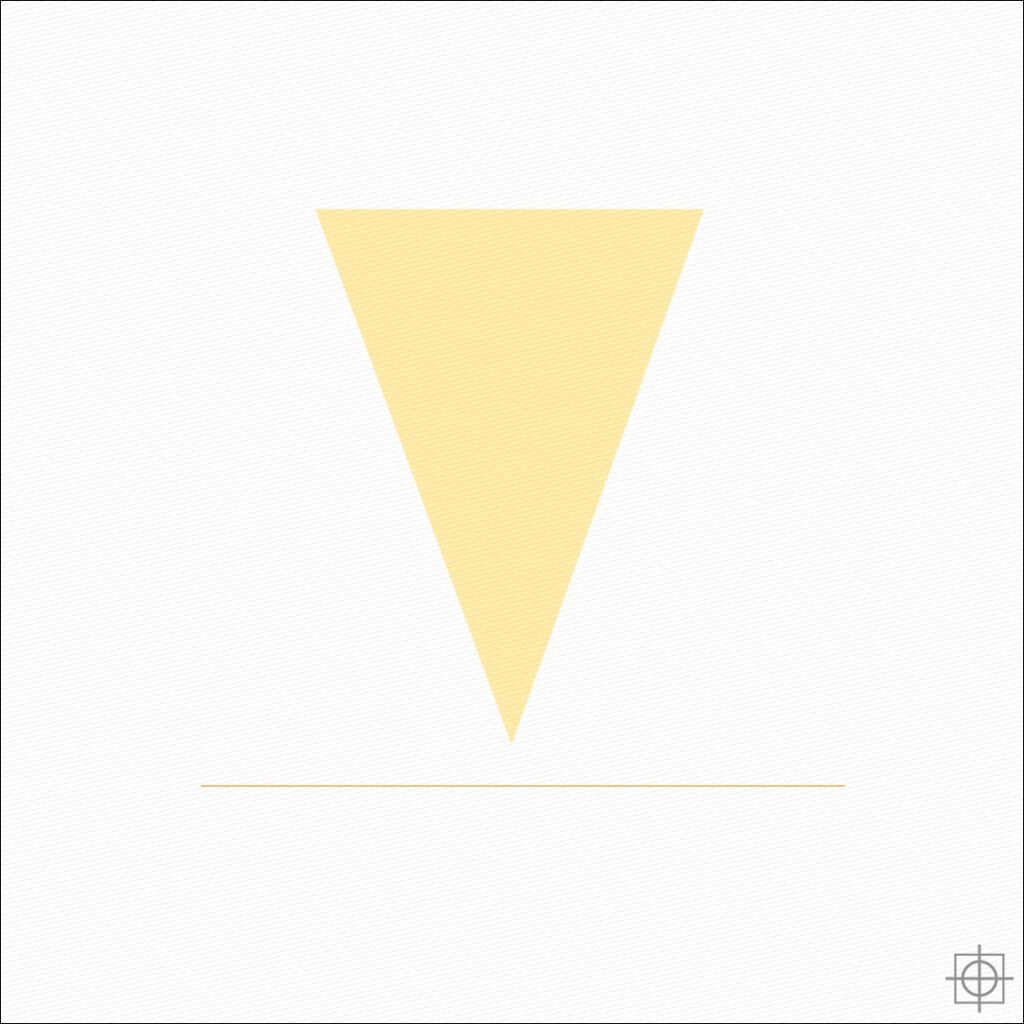
橢圓和倒三角造成不同的視覺效果
女性,作為被觀看的客體,通過形式多樣、目的相同的“快速挑逗”,喚起男性看客不可言說的性幻想與性快感,這種大眾評價和商業上的認可,又讓無數女性伴隨“羊群效應(Bandwagon Effect, [10])”, 前仆後繼、重蹈覆轍地去節食、整形、P圖,深陷商業化圖景下定義女性的惡性循環。
美,是一種哲學,是一門宗教,它是上帝賦予人類最珍貴的禮物。美是真實、是善意、是生命力量自然而然的勃發和流動,是你經過的路,是你遠望的雲,是無意中那樸實的光,也是寒冷的暗夜裡溫暖你的暖。
珍愛自己的美,用多元和包容的眼光看待這個世界的,這可能不是從前的樣子,不是未來的樣子,但肯定是生命本來應該有的樣子。
註釋
[1]. 畢達哥拉斯(Pythagoras, Πυθαγόρας), 古希臘哲學家、數學家和音樂理論家,畢達哥拉斯主義的創立者,畢氏學派的創始人。由於他「萬物皆數」的信念,為希臘數學的昌盛奠下基礎。
[2]. 斷臂美神(Vénus de Milo, Αφροδίτη της Μήλου), 也稱米洛的維納斯,是著名的古希臘雕像,創作於西元前130到100年之間,是希臘神話中愛與美的女神阿佛洛狄忒(羅馬神話的維納斯)之雕像。
[3]. 擲鐵餅者(the Discobolus of Myron, Δισκοβόλος), 古希臘雕塑家米隆的代表作,完成於古風時期末,已失傳,目前看到的是青銅複製品。
[4] 桑德羅·波提切利(Sandro Botticelli), 歐洲文藝復興早期的佛羅倫斯畫派藝術家。
[5]. 維納斯的誕生(La Nascita di Venere), 波提切利最著名的作品之一,描述羅馬神話女神維納斯從海中誕生之場景。
[6]. 李奧納多·達芬奇(Leonardo da Vinci), 義大利文藝復興巨擎,與米開朗基羅和拉斐爾並稱為文藝復興三傑。
[7]. 蒙娜麗莎(La Gioconda, Mona Lisa), 達芬奇所繪的肖像畫,乃其代表作。
[8]. 岩間聖母(Vergine dell Rocce), 達芬奇兩幅畫板油畫之統稱,構圖基本相同,一幅畫現藏於羅浮宮,另一幅畫現藏英國國家美術館。
[9]. 拉斐爾·桑齊奧(Raffaello Sanzio da Urbino), 義大利畫家、建築師,文藝復興三傑之一。
[10]. 從眾效應(Bandwagon effect), 指人們受到多數人的一致思想或行動影響,而跟從大眾之思想或行為,也稱為羊群效應(Herd behavior)。
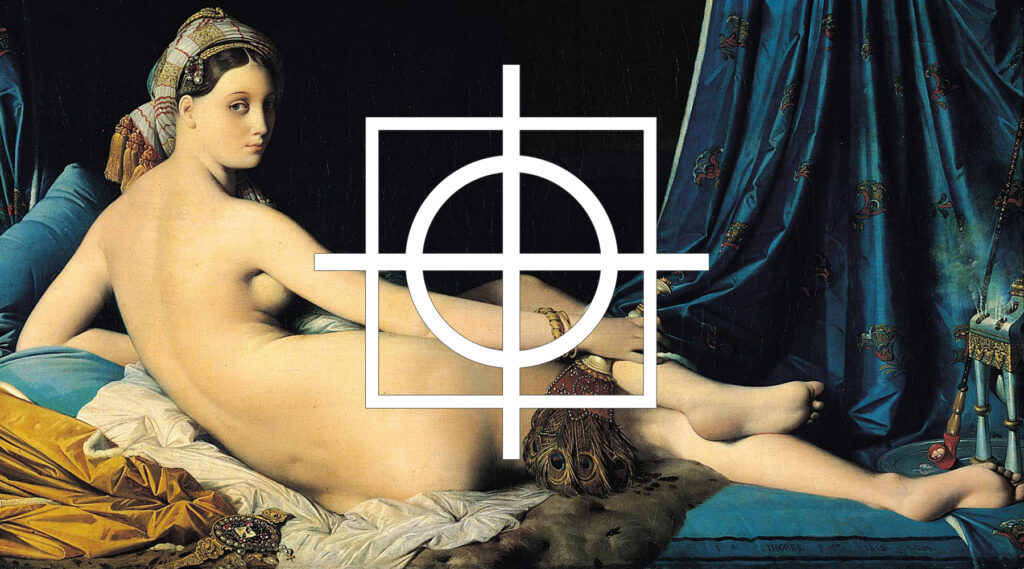
EN
This article was first published on WeChat official account: 人面魚Fisage, co-authored by me and my wife, it has been revised since then.
1. What is so-called “Awl-Face”: Inverted Drip of Water, Pointed Chin
and Snake-Demon Face
The so-called “Awl-Face(錐子臉)” is commonly seen along with the internet celebrities, which is an extreme exaggerating version of the “melon-seed-face(瓜子臉)”. In this kind, a woman’s face dose not have protruding masseter muscles or the angels of mandible(lower jawbone) are not so obtrude, the chin is sharp like an awl, the whole skull is like an inverted “drip of water”. Countless female stars and internet celebrities go to have plastic surgeries to chip their big rami of mandibles to small ones, rub their tiny rami of mandibles to flat ones, or use Adobe Photoshop to manipulate their digital images as much as possible. As a result, nearly all stars and internet celebrities have some identical faces, all have white, thin “awl-faces”, big eyes and high noses. It is really ridiculous and notorious! These women must be crazy and insane, if our æsthetics has no problems, then the æsthetics of our times is certainly ill.
2. The Western Classic Æstheticism of Woman Tends to Praise
the Vitality with Willful Powers
In the coordinate system of history in the Western Civilization, from Ancient Greece to Renaissance, the western mathematicians and geometers had defined the most suitable æsthetic ratios for human body according to the basic principes of geometry and mathematics: the eclipse is the perfect shape for human’s face.
The ancient Greek philosophers thought they could explain the world and universe according to the law and relationship of mathematics. Pythagoras(Πυθαγόρας ὁ Σάμιος, [1]) was always regarding the sphere(circle) as the impeccable shape, so should the universe be a sphere. The human body, as a simple miniature of the whole universe, the best ratio for the height of human body should equal to the length of nine heads while the perfect shape for head is the eclipse. The round shape makes us feel stable and complete, the contour is natural and fluent, which is a symbol of beauty and goodness with self-sufficient, recycling and endless vitalities, in such ideology, they had brought us the famous Vénus de Milo (Αφροδίτη της Μήλου, [2]), the Discobolus of Myron (Δισκοβόλος, [3]). In the Renaissance, no matter the the visages of goddesses from Botticelli’s [4] La Nascita di Venere (The Birth of Venus, [5]), or Leonardo da Vinci’s [6] Mona Lisa(La Gioconda, [7]) and Vergine dell Rocce (Virgins of the Rocks, [8]), the heads of all main characters are some pretty elegant, beautiful round shapes hidden in the soft, charming and delicate tones of shadows with various, different, layers of shade — we shall never forget that Leonardo da Vinci, as a pupil, had been forced to draw eggs without end by his teacher — or Raffaello’s [9] somewhat über-sweet portraitures of the Holy Family: every single head of the figures has a graceful, enchanting egg-shape with polished, gentle curves of contours. Even in modern Royal Court of France(cour de France), all the noble ladies and queens, were proud of their round, porcelain-like, sculptural heads and their sexy, sensual, plump, elastic fleshes and bodies with blooming and florescent vitalities.
In another words, the history of Western classical æstheticism from ancient Greece to the modern times is a history of praising and honouring the beautiful, splendid and blooming young valours with enormous vitalities and fertile power for multiplying. And it’s no wonder that none of all countless female nudes in Western classical artworks are not plump, sexy, tender, delicate with ample power, strength and tenacity, shimmering and glimmering in the first flash of light of crepuscular, capering and dancing on the surface of their bodies.
3. The Classic Chinese Æstheticism: Weak to Satisfy Men’s Desire of Protection, Enchanting to Fulfill Men’s Alien Lusts
When I was a young girl, I wasn’t content with my body and figure: I was not tiny or delicate enough. The most beautiful girl in my mind should have “melon-seed-face(瓜子臉)”, “willow-leaf eyebrow(柳葉眉)” and tiny, lovely “cherry-lips(櫻桃小嘴)”. No matter Lin Daiyü(林黛玉, [10]) from “Dream of the Red Chamber(紅樓夢, [11])” or Cui Yingying(崔鶯鶯, [12]) from “The Story of the Western Wing(西廂記, [13])”, they are all “Still as delicate flowers reflected upon the water, Moving as weak willows in the wind (靜若嬌花照水,動則弱柳扶風).” Only this kind of girl can stir the inner desire of protection and possession for Chinese men.
Contrary to the ample, plump female figures with wilfully growing sensual power in the Western oil paintings, the traditional Chinese female characters have slim, weak figures, “melon-seed-face(awl-face)”, oblique shoulders(削肩), thin waistline(小蠻腰) and binding feet(三寸金蓮), which represent some æsthetic concepts of “male chauvinism(大男子主義)” in hearts of Chinese men, different from those of Westerner’s. The Chinese men have been influenced by traditional Confucianism and the Cheng–Zhu school’s(程朱理學, [14]) ideas that “Long lives the Tao of heaven, completely suppress the desires of men (存天理,滅人欲)”, bondaged and imprisoned by the rules and frameworks in the relationships of “Lord-Vassal-Father-Son (君君臣臣父父子子)”, controlled and played as puppets by the perplex, complicated moral system of Confucianism, their power of vitalities have been depressed and diminished for a long period of time, yet their false sense of pride and vain glory actuate and force themselves to satisfy their inner desire of controlling and sense of superiority by “weakening the females” and adopting the polygyny, indulging themselves in the unequal relationship between man and woman.
Though the necessities and expectations for woman’s role in the traditional family of Chinese men have developed and evolved another kind of æstheticism: woman with round, “egg-like face(鵝蛋臉)”. Apart from the weak, soft, delicate, sensitive, childish or even neurotic character of the “melon-seed-face” woman, there is another wonderful female character from the same novel “Dream of the Red Chamber”, Xue Baochai(薛寶釵, [15]) with egg-shape face. Apparently, she is a typical “good wife” that most Chinese men from traditional big family would seek after: she knows the conditions and the whole scenes, getting along well with others, good at handling difficult, complicated relationships among family members, stronger with much more power. This kind of woman with round face just fulfills another fantasy of Chinese men: she loves and obeys her father-in-law and mother-in-law, keeps good relationships with all members of the family, and never acts like all the female characters in “Jin Ping Mei(金瓶梅, [16])”, which shakes the very foundation of the entire family. She should be kind-hearted and much tolerable, could even sacrifice herself for the sake of the whole family. The Chinese men will need a powerful woman to awaken his weak and incompetent vitality inside when encountering setbacks, while they still tend to enjoy the sense of superiority from the worship of the fellow delicate, weak women in their daily life. In some significations, the women with “melon-seed-face” is a reflection of women with “egg-face”, they are the mirrors of each other, a kind of another inter-complementary imagination of women’s power for Chinese men.
Just as there is a perfect, eternal wife with “egg-face” in men’s minds, so is there another inamorata with “melon-seed-face” lingering in their yearning hearts. On seeing their wives, the married men will always be drowned in sense of endless responsibilities and infinite, hard, weighted pressures, but the mistresses will certainly bring them sense of desires, vents and relaxations. The contemporary Chinese men have been completely controlled and dominated by money and lusts, and the greedy, eager and hungry women are voluntarily changing themselves into the nodes for the male desires. By plastic surgeries, they have transformed themselves with much-sought-after “awl-face”, big eyes, blepharoplasty(double eyelids), high noses and pointed chins, they hope to catch and hold a ticket for the street car named desire into the ocean of lusts.
Additionally, in the theory of ancient Chinese physiognomy, the ample, happiness-earning and rewarding “egg-face” has many more advantages over the “melon-seed-face” with less rewards and happiness in the real life: the round forehead without any protruding parts implies that she won’t be conflicting with others; the small zygomatic bone indicates that she is supple and not too mighty or strong towards others; the contour of chin dose not destroy the outline of the entire visage, meaning that she is not picky and easy to get along with; and if the woman has a little upturned mandibula(jawbone), then she can certainly earn her rewards and wealths, living a graceful life in her old ages. All the hair, skin, fleshes and bones are passed from our forefathers to us, if our women deny our own characteristics and ingratiate the common stereotyped æstheticism of the epoch, it’s just only a result of insufficient self-confidence, lacking of self-judgement and self-insisting.
4. Debris, Pleasure and Swallow Depth —
the Ridiculous, Fastfood-like Æstheticism in the Times of Internet
This is the best of the time, this is the worst of the time. Charles John Huffam Dickens
“This is the best of the time, this is the worst of the time (Charles John Huffam Dickens).” It seems like the women have been liberated and released from the out-dated moral systems of Confucianism lasting for thousands of years, but they are falling into another trap in the epoch of “Female Consuming”.
This is, a buzzard and weird times, with the desires and lusts ruling all. In the magazines, on the screens, in the main windows of countless Apps for live broadcasting, the beauty of women has attracted so much spotlight of desires, which can be easily transformed into profits, earning a lot of interests. Compared to the round face or “egg-face”, the “awl-face” would appear much more pretty and attractive in front of the lenses, arousing much more desires and bringing much more sexual fantasies for the males. Women with “awl-face” will surely appear much more enchanting, flattering and fashionable with much more sexual attractions than women with “egg-face”—From the visual perspective, the oval is formed by bi-balanced forces, making the viewer peaceful and tranquil with sense of safety, while the “melon-seed-face” like a reversing drip of water with a pointed angle beneath will cause some unstable and uneasy feelings, a symbol of impatience, turmoil and flirtation. For example, even in the marvel tales of “Strange Stories from a Chinese Studio(聊齋誌異, [17])”, the descriptions of daughters from big, noble families are differentiated from those of female ghosts, monsters and demons — the enchanting fox-demons and luring snake-demons are always having a pointed chin and a pair of charming, flirting, big eyes.
Female, as an object of seeing, aims to arouse the sexual pleasure of the male audiences by multiple forms and varied means with the same single goal to “attract and flirt” men as quickly as possible. The massive public commentaries and the commercial approvals in the end have also urged and compelled numerous women to follow in the “bandwagon effect [18]”, one after another, along the same tracks to have diets, to take plastic surgeries, to manipulate their images in Photoshop, and to be trapped deep inside the vicious circle of female definition in the commercial landscapes.
Beauty, is a type of philosophy, a kind of religion, a most precious gift that God have granted to all human being. The beauty is true, is kind, is a natural blooming and flowing of the vitality and power. It is the road you have taken, the cloud you have seen from distance, the simple yet honest light you have glimpsed by accident, and the heath that have warmed you in the cold, dark night.
All women should cherish our own beauty, perceiving the world with multiple and inclusive points of view. This may not be the same as before, neither the same in the future, but certainly it should be the original form of the life itself.
NOTES
[1]. Pythagoras(Πυθαγόρας), an ancient Ionian Greek philosopher and the eponymous founder of Pythagoreanism. His political and religious teachings were well known in Magna Græcia and influenced the philosophies of Plato, Aristotle, and, through them, Western philosophy.
[2]. Vénus de Milo(Αφροδίτη της Μήλου, Aphroditi tis Milou), an ancient Greek statue and one of the most famous works of ancient Greek sculpture.
[3]. Discobolus of Myron(Δισκοβόλος, Diskobólos) is a Greek sculpture completed at the start of the Classical Period, figuring a youthful ancient Greek athlete throwing discus, about 460–450 BC.
[4]. Sandro Botticelli, was an Italian painter of the Early Renaissance.
[5]. La Nascita di Venere(The Birth of Venus), is a painting by the Italian artist Sandro Botticelli, probably made in the mid 1480s. It depicts the goddess Venus arriving at the shore after her birth, when she had emerged from the sea fully-grown.
[6]. Leonardo da Vinci, was an Italian polymath of the High Renaissance who is widely considered one of the greatest painters of all time.
[7]. Mona Lisa(La Gioconda) is a half-length portrait painting by the Italian artist Leonardo da Vinci. It is considered an archetypal masterpiece of the Italian Renaissance.
[8]. Vergine dell Rocce(Virgins of the Rocks), is the name of two paintings by the Italian artist Leonardo da Vinci, of the same subject, with a composition which is identical except for several significant details.
[9]. Raffaello Sanzio da Urbino, known as Raphael, was an Italian painter and architect of the High Renaissance.
[10]. Lin Daiyü(林黛玉), is one of the principal characters of Cao Xueqin’s(曹雪芹) classic 18th century Chinese novel Dream of the Red Chamber.
[11]. Dream of the Red Chamber(紅樓夢), composed by Cao Xueqin, is one of China’s Four Great Classical Novels.
[12]. Cui Yingying(崔鶯鶯), is a fictional character from Romance of the Western Chamber, a Chinese play by Wang Shifu(王實甫).
[13]. The Story of the Western Wing(西廂記), is one of the most famous Chinese dramatic works.
[14]. The Cheng–Zhu school(程朱理學), is one of the major philosophical schools of Neo-Confucianism, based on the ideas of the Neo-Confucian philosophers Cheng Yi(程頤), Cheng Hao(程顥), and Zhu Xi(朱熹).
[15]. Xue Baochai(薛寶釵), is one of the principal characters in the classic 18th century Chinese novel Dream of the Red Chamber.
[16]. Jin Ping Mei(金瓶梅), is a Chinese novel of manners composed in vernacular Chinese during the late Ming dynasty (1368–1644).
[17]. Strange Stories from a Chinese Studio(聊齋誌異), is a collection of Classical Chinese stories by Pu Songling(蒲松齡), comprising close to five hundred “marvel tales”.
[18]. Bandwagon effect, is a phenomenon whereby the rate of uptake of beliefs, ideas, fads and trends increases with respect to the proportion of others who have already done so.
聲明: 本篇音樂來自莫扎特(Wolfgang Amadeus Mozart)歌劇《魔笛(Die Zauberflöte, K620)》第二幕的《夜后復仇詠嘆調(Act 2 “Der Hölle Rache Kocht In Meinem Herzen” [Königin Der Nacht])》表演者: 皮拉•羅仁格爾(Pilar Lorengar), 瑪爾蒂•塔爾維拉(Martti Talvela)等, 指揮: 喬治·索爾蒂爵士(Sir Georg Solti), 維也納愛樂樂團(Wiener Philharmoniker), B0000041QO, DDD, Decca (2007); 歌曲《枉凝眉》,來自電視連續劇《紅樓夢》, 演唱者: 曲丹。名詞解釋來自《維基百科全書(Wikipedia)》, 所有藝術品圖片、劇照和明星照片均來自國際網路,其它文字、翻譯及圖片均為原創,請勿用於商業用途,謝謝!
